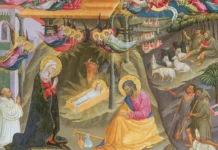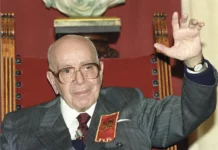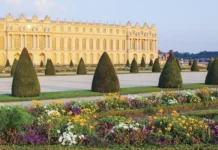Commenting on the feelings elicited in his soul by the contemplation of the fresco of Our Lady of Good Counsel, Dr. Plinio describes the enchanting intensity of the relationship between the Child Jesus and His Most Holy Mother.
The invocation of Our Lady of Good Counsel may appear, at first sight, not to bear much relation to the fresco. The latter portrays a Queen of a small Balkan country, which can be perceived in the figure, the ornaments, and above all in the distinctly eastern traits, with her slightly almond-shaped eyes, sloping downwards.
She is holding the Child in her arms in a gesture of extreme intimacy, giving the impression of having forgotten that She is Queen and He is King! Not as though they had resigned or abdicated from their royalty, but as though, for the moment, what is foremost in their attention and their sentiments the fact that She is Mother and He is Son!
Depth of sentiment and thought
One of the things that attracts me most in this image is the way it conveys the profound intimacy in the relationship between them, which one is able to sense in the deepest recesses of their soul: Our Lady is Mother, and Mother of that Son; She loves that Son. Our Lord is Son, and Son of that Mother!
The union of soul between Mother and Son explains the tranquillity and almost immobility of their affection. It has reached such a depth that there is nothing to say to each other. They remain still, only loving each other, as if realizing that, on both sides, knowledge and affection have reached their limit. There is nothing more to be considered; all that remains is to enjoy the blessed delight of that mutual understanding and togetherness!
On this point the artist was very sensitive, because he painted the Child with all the features of an in infant of that age, in no way representing a precocious “little man”, and yet with a depth of sentiment and thought that not even a grown man has. And this corresponds entirely to the Catholic doctrine on the God-Man.
As a consequence of the unity between the divine and human natures in the same Person, that Child, at that age, conceived without original sin, and therefore without having experienced any of the weaknesses and – I say this in the Latin etymological sense – imbecilities and frailties of childhood, has this perfection of feeling. He is aware of who this Mother is, of the profound depths of soul that She offers Him, and He enters so deeply into those depths that He places Himself in her hands like a little child!
There is a sublime paradox here: this Child is a child in every way, except in understanding and desiring sublime, extraordinary things. I do not find it astonishing, then, that He wished to depend on Her for the most basic and ordinary needs, for this is in keeping with the Child-God’s condition as a child.
A painting with extraordinary supernatural insight
The fresco expresses this admirably. It is an average work of art, but with extraordinary supernatural insight! It gives us a good idea of the relationship between them.
Our Lady carries the Child as someone who carries a treasure of infinite value, but also as a very generous person. When we imagine someone carrying a treasure, we picture him clutching it, bent on preventing someone from stealing it, and with the attitude of one who says: “This is mine, not yours! Don’t come near it and don’t touch it, because it’s mine!” But She does not do this.
Our Lady holds her Divine Son with great care and delicacy, in such a way that nothing happens with Him or around Him without being immediately noticed by His Most Holy Mother. She exercises the sweetest motherly vigilance, but She does not show the slightest concern that He might be taken from her arms. She knows that She possesses a treasure that is not divided when shared: in bestowing it upon another, She understands that it remains entirely with the one who gives and the one who receives.
In the painting, the position of Our Lady’s face has been carefully calculated so that, without actually displaying the Child, nothing of His face is hidden. He is in the foreground while She is in the background.
By the respect and by the calm, relaxed and affectionate seriousness with which She carries Him, one sees that She is fully aware that She is carrying the Son of God. She adores Him with the deepest respect, but at the same time feels pervaded by the affection of the One whom She respects, to the point that She feels free to give orders to her own God without any hesitation or diffidence.
It is up to Our Lady to choose when to lay Him down or pick Him up from the cradle, to decide whether or not the moment of repose has come. Even knowing that She is nothing, or as if nothing, before the Creator, She is not afraid to say, “My God, the time has come to rest!” And He, whose human nature is hypostatically united to the Second Person of the Blessed Trinity, closes His eyes and sleeps, because His Mother so bid.
Implications of the Incarnation

The above reflections fit into the “et Verbum caro factum est, et habitavit in nobis” of the prologue of St. John’s Gospel: “the Word became flesh and dwelt among us” (Jn 1:14). This entire heavenly whirlwind of vertiginous, admirable and most sweet relations is an unfolding of the Mystery of the Incarnation.
We do not have any details from the daily life between Mother and Son, but it could have happened, for example, that the Child Jesus, when He was a little older, wanted a ball to play with, but He could not ask for it because He could not yet speak. God wanted to play! And it was up to His Blessed Mother to surmise, through love, what He wanted.
We can imagine Our Lady and St. Joseph discussing the size, the diameter of this ball, the material to be used in making it, how to make it hollow so that it would not be too heavy in His little hands, and so on. But imagining, at the same time, on top of this ball, a cross like those we see on the orbs held by countless kings on earth!
We can also imagine the Blessed Virgin attentively watching to discover His preferred food, or praying to Him to know what meal He wanted that day. And the Child Jesus, still struggling to speak, babbling some words whose meaning she was able, in a mysterious way, to perceive: “My Mother, do you not know that I have come to earth to suffer?”
No one can imagine the relations between Our Lady and her Divine Son during His childhood, or the mysteries and sublimity of a God still of an age to play! Scripture says that, before all the ages, Eternal Wisdom also played upon the globe of the earth (cf. Pr 8:27-31). But between that and a little ball made in the workshop of Nazareth… What a difference!
The Mother I created and from whom I was born
Now, if Our Lord transfigured Himself for the three Apostles on the heights of Mount Tabor, how many times would He have transfigured Himself for Her? And at what moments? During His sleep, perhaps…
What power, majesty, innocence and delicacy must the Child Jesus have manifested while He slept! But sometimes, as His Mother contemplated Him, She would see in Him, suddenly and fleetingly, not just an extraordinary child, but God Himself!
We know from Genesis that before resting, God “saw everything that He had made, and behold, it was very good” (Gn 1:31). But nothing that He had made was as sublime as Our Lady. Upon beholding Her, the Child Jesus, as Creator, conferred – so to speak – with His human nature and thought: “How beautiful is this Mother whom I have made, and from whom I was born! What an incomparable soul!”
The door of her room being ajar, He sees Her praying, illuminated by the light of a flickering lamp. He notices that She is praying to Him, but does not enter the room. He realizes that She is also praying to the Eternal Father and to the Divine Spirit, and, as the Second Person of the Blessed Trinity, He is cognizant of her prayers. However, the time has come to call upon Her to look after some concrete need, and so He cries out: “Mama!”
Situations like this transpired on innumerable occasions. At a certain moment, Our Lord sees Her weeping. The Blessed Trinity, of which He is a part, is explaining to Her about His Passion and Death. He notes His Mother’s docility and, at the same time, the sword that pierces her soul. He delights to consider that, out of her love for mankind, She also accepts and desires His death. And the next day, when She rises, He perceives in her countenance a furrow of sorrow that imparts to Her a truly indescribable majesty, gravity and recollection.
We can also imagine Our Lady having prophetic knowledge of the miracles, teachings and parables of her Divine Son, or seeing His figure ascending to a mountaintop. The Passion, Cross, Death and the glory of the Resurrection… Who could adequately imagine all of this? No one!
The picture at St. Louis College
At St. Louis College, there was a picture of the Mother of Good Counsel placed on the altarpiece of the modest chapel, a room transformed into an oratory, into which I entered countless times.
To celebrate the month of May, for example, all the pupils would enter the chapel every day, singing in honour of Our Lady. On those occasions, I would naturally look at the image and my attention would be drawn both to the Mother of God and to the Child Jesus, but considered on a theoretical level, according to the notions supplied by Catholic Doctrine, as far the mind of a child is capable of grasping them.

Then I thought: “Here is the Mother of God, Mary Most Holy, who gave me that grace in the Sacred Heart of Jesus Church. I see Her here under another invocation, and with different vesture. But She is the same! I am going to pray to Her, because I have already experienced how kind She is to me, and without that I will not manage to succeed. However, with her mercy I can attain everything. Here is another opportunity to unite myself to Her.”
I knew that the name of that picture was Mater Boni Consilii, therefore, Mother of Good Counsel. I tried sometimes to pray under this invocation, which I perceived was excellent, but it did not mean a great deal to me, because the life of piety is like that: at times, something excellent does not speak clearly to our soul.
This gulf remained until I read a book on Our Lady of Genazzano just before I had the diabetic crisis, and all the subsequent events had taken place.1 At that moment, something happened that was similar to a beam of light which, born from a small but bright lamp, becomes immense. From that first glimpse emerged a devotion that has marked my life. ◊
Taken, with adaptations, from:
Dr. Plinio. São Paulo. Year XVIII.
N.205 (Apr., 2015); p.22-25.
Notes
1 Cf. CLÁ DIAS, EP, João Scognamiglio. O dom de sabedoria na mente, vida e obra de Plinio Corrêa de Oliveira [The Gift of Wisdom in the Mind, Life and Work of Plinio Corrêa de Oliveira]. Città del Vaticano-São Paulo: LEV; Lumen Sapientiæ, 2016, v.IV, p.237-332.







